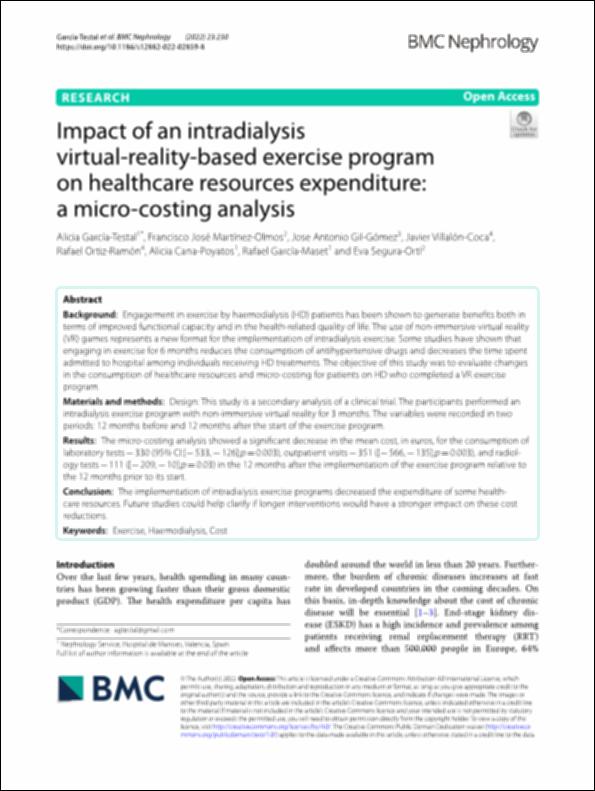Please use this identifier to cite or link to this item:
http://hdl.handle.net/10637/14208Impact of an intradialysis virtual-reality-based exercise program on healthcare resources expenditure a micro-costing analysis
| Title: | Impact of an intradialysis virtual-reality-based exercise program on healthcare resources expenditure a micro-costing analysis |
| Authors : | García Testal, Alicia Martínez Olmos, Francisco José Gil Gómez, José Antonio Villalón Coca, Javier Ortiz Ramón, Rafael Cana Poyatos, Alicia García Maset, Rafael Segura Ortí, Eva |
| Keywords: | Kidneys - Diseases - Physical theraphy.; Hemodialysis - Patients - Quality of life.; Hemodiálisis - Pacientes - Calidad de vida.; Ejercicio físico - Uso terapeútico.; Riñones - Enfermedades - Fisioterapia.; Exercise - Therapeutic use. |
| Publisher: | Springer Nature |
| Citation: | García-Testal, A., Martínez-Olmos, F. J., Gil-Gómez, J. A., Villalón-Coca, J., Ortiz-Ramón, R., Cana-Poyatos, A., García-Maset, R. & Segura-Ortí, E. (2022). Impact of an intradialysis virtual-reality-based exercise program on healthcare resources expenditure: a micro-costing analysis. BMC Nephrology, vol. 23, n. 1 (27 jun.), art. 230. DOI: https://doi.org/10.1186/s12882-022-02859-8 |
| Abstract: | Background: Engagement in exercise by haemodialysis (HD) patients has been shown to generate benefits both in terms of improved functional capacity and in the health-related quality of life. The use of non-immersive virtual reality (VR) games represents a new format for the implementation of intradialysis exercise. Some studies have shown that engaging in exercise for 6 months reduces the consumption of antihypertensive drugs and decreases the time spent admitted to hospital among individuals receiving HD treatments. The objective of this study was to evaluate changes in the consumption of healthcare resources and micro-costing for patients on HD who completed a VR exercise program. Materials and methods: Design: This study is a secondary analysis of a clinical trial. The participants performed an intradialysis exercise program with non-immersive virtual reality for 3 months. The variables were recorded in two periods: 12 months before and 12 months after the start of the exercise program. Results: The micro-costing analysis showed a significant decrease in the mean cost, in euros, for the consumption of laboratory tests − 330 (95% CI:[− 533, − 126];p = 0.003), outpatient visits − 351 ([− 566, − 135];p = 0.003), and radiology tests − 111 ([− 209, − 10];p = 0.03) in the 12 months after the implementation of the exercise program relative to the 12 months prior to its start. Conclusion: The implementation of intradialysis exercise programs decreased the expenditure of some healthcare resources. Future studies could help clarify if longer interventions would have a stronger impact on these cost reductions. |
| Description: | Este artículo se encuentra disponible en la siguiente URL: https://bmcnephrol.biomedcentral.com/articles/10.1186/s12882-022-02859-8 |
| URI: | http://hdl.handle.net/10637/14208 |
| Rights : | http://creativecommons.org/licenses/by/4.0/deed.es |
| ISSN: | 1471-2369 (Electrónico) |
| Language: | es |
| Issue Date: | 27-Jun-2022 |
| Center : | Universidad Cardenal Herrera-CEU |
| Appears in Collections: | Dpto. Enfermería y Fisioterapia |
Items in DSpace are protected by copyright, with all rights reserved, unless otherwise indicated.


